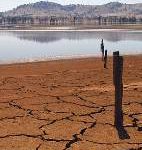Between October 2008 and February 2009, the central Chinese province of Henan endured its worst drought since 1951.
Henan was not the only province affected. Many provinces, including Hebei, Shandong and Anhui, have suffered a lack of rainfall; some areas have gone without precipitation for 100 days. According to figures from the Office of State Flood Control and Drought Relief Headquarters (SFDH), at the height of the drought on February 7, 2009, 107,333 square kilometres of cropland were affected – around double the annual average of 50,666 square kilometres. Rural residents have been worst affected, with millions left short of drinking water.
The drought has now been eased by a number of rain and snow falls. This may have calmed the worries of many people, but the sad truth is that the drought will be back again. As the SFDH points out, droughts have long been a problem for China, particularly in the basins of the Yellow River and Huai River in the north, where water pressures are most acute. This area has only 7% of the nation’s total water resources, and sees droughts nine years out of every 10. The Chinese government and the people must face up to the fact that droughts are a regular occurrence.
Australia has suffered terrible drought for the past several years, which many scientists link to global warming. This helped to focus climate change as a political priority, which led to prime minister Kevin Rudd signing the Kyoto Protocol at the 2007 UN-led climate-change talks in Bali, Indonesia.
In China, global warming will worsen already grave water shortages. The government and the people are taking action on climate change, but this year’s drought needs to refocus our attention on the problem.
Many experts are giving recommendations for dealing with the symptoms of the drought. Irrigation equipment has been left for years without maintenance in many Chinese fields and some call for increased investment in bolstering anti-drought technology; others call for the popularisation of water-efficient agriculture.
They are not wrong. A lack of long-term government spending on irrigation and water-saving technology – combined with the low returns from agriculture that have caused farmers to leave the land and look for work elsewhere – means that Chinese agriculture is very inefficient in its use of water resources.
A report from the World Bank in January, Addressing China’s Water Scarcity [pdf], put the value of China’s productivity per cubic metre of water at US$3.60, compared to US$4.80 for average middle-income countries and US$35.80 in high-income countries. The most important factor is agriculture, which uses two-thirds of China’s water. The Ministry of Water Resources says that only 46% of water used in irrigation actually reaches the crops. In developed countries this figure is between 70% and 80%.
A survey by the Chinese Ministry of Agriculture found that before Chinese New Year, over 20 million migrant workers had lost their jobs in the recent economic downturn and returned to their villages. Encouraging these people to help save water in agriculture will help increase water efficiency and could provide employment for some.
Qian Zhengying, a member of the Chinese Academy of Engineering and former minister of water resources, wrote with colleagues in Science Times that there is more to water-saving in agriculture than simply improving irrigation. They write that the balance of crops, forestry and livestock needs to be adjusted across arid and semi-arid regions to ensure that local industry is suited to the natural environment. For example, the decision not to plant water-intensive rice crops around Beijing has helped reduce water use.
Farmers need to cut water use, but so do households and industry. And if water pollution is not controlled, the country’s water crisis will only worsen.
China is currently working on a huge water engineering project known as the South-to-North Water Transfer Project, which aims to move much-needed water across regions. The eastern branch of the project will take water from the lower reaches of the Yangtze River and the central branch of the Han River. Plans will see at least half of the water carried by the eastern branch used in agriculture, while the central branch will meet urban and industrial demand in cities like Beijing and Tianjin.
Although the central branch passes through central Chinese provinces such as Hunan and Hubei, they will not benefit until it starts carrying water in 2014. At that time, water shortages may be relieved to some extent, but the real solution will only be water conservation and the improvement of water management.
Water resources minister Chen Lei stressed the importance of implementing strict rules on water management at a national meeting on February 14. These should include, he said, laws, regulations and policies on water use and the setting of “red line” benchmarks for water resources, which must not be crossed.
But water management is not a matter only for the Ministry of Water Resources – or indeed the government. The World Bank report points out how China needs to shift from the traditional top-down model of water management to a more modern style.
The report suggests forming a national water resources committee to lead and coordinate water affairs, or combining departments with responsibility for water management at the ministries of water, environmental protection, housing and urban-rural development into one new ministry. It also emphasises how full use can be made of market measures, such as water rights, water pricing and environmental compensation mechanisms; and says that public participation should be put on a sound legislative footing.
The suggestions are all pertinent. Let us hope this latest drought can raise awareness about the need to change China’s water management systems.
Li Taige is a Beijing-based journalist. He obtained a masters degree in engineering from Sichuan University in 1997, and studied as a Knight Science Journalism Fellow at the Massachusetts Institute of Technology (MIT) in 2003-2004.
Homepage photo by GraemeNicol



